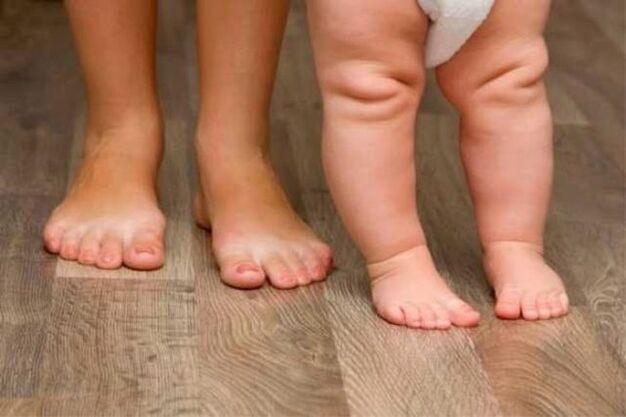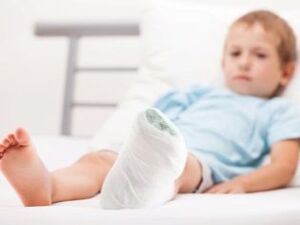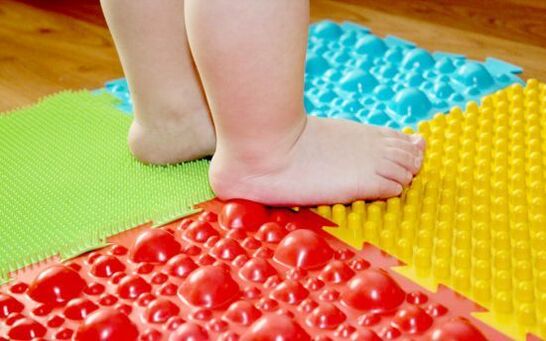Sweat-valgus foot-the most common children's orthopedic pathology.She usually encounters her in the first years of the child’s life, because she becomes obvious after the baby begins to master independent walking.What to do if such curvature is found, we will tell in this article.

What is valgus deformation
In fact, valgus deformation and flat feet are different pathologies of the lower extremities, but in children it is most often that a combination of a decrease in the arch of the feet, characteristic of flat feet, and a change in the position of the foot at the load with an oral displacement, characteristic of valgus deformation, is most often observed.
Valgus curvature is such a deformation in which the child in an upright position is based mainly on the inner part of the feet, and the fingers and heels are deployed in the external direction.
Normally, the setting of the legs should be parallel, that is, when looking at two standing legs behind, you can mentally draw two straight vertical lines.In a child with valgus deformations, these lines are refracted in the area of the ankle joint with a deviation to the outside, which determines the second name of the pathology-X-shaped deformation.
With flat feet, everything is much more complicated.All children from birth have a physiological flat foot, so it is impossible to consider this a pathology at 1-2 years.However, orthopedists consider the problem comprehensively, and a diagnosis-flat-valgus deformation appears in the child’s medical record in the medical record.
It is rare enough, but valgus curvature can be innate.For some reason, the lower limbs of the fetus in the womb begin to develop abnormally.Such legs are visible almost immediately after the birth of the baby is born, and at 2-3 months the diagnosis is usually made quite reasonably.
A flat-walgus foot is not a sentence.With timely treatment, with a responsible and systematic approach to it of parents, the function of the foot in case of mild pathology can be restored in full.It all depends on the degree of the disease.
Flat - valgus deformation of the feet - how to correct the defect?
Frying Valgus installation of the stop - an orthopedic anomaly, which is characterized by deformation changes in the foot, which is found in both adults and in children.
Deformation is a violation of the surface of the foot, when its middle part is displaced down, and the fingers and heels are turned outward.
The reason for the abnormal development of the foot lies in the weakness of the ligaments, muscles and tendons, when the foot is attracted to them under the influence of stronger muscles.The result of this effect is the formation of flat feet.
Planealgus deformation of the feet is essentially the same flat feet, a very common defect that is found in every fifteenth resident of the planet.The disease is difficult to treat, and the treatment process itself is long and problematic.
The reasons for the development of pathology
During the evolution, our foot was formed in such a way as to take on and evenly distribute the weight of the human body.The role of the foot is to ensure the greatest depreciation while walking, running and jumping.
In addition, thanks to the unique anatomical structure of the foot, a person goes in an upright position, without falling over to the right - left, back and forth.The protruding vaults of the feet are directed in two directions: transverse and longitudinal.
So, an adult has three points as a support:
- element of large plus bone;
- heel hillock;
- The fifth plus bone.
Pathology occurs in young women much more often, since they wear high -heeled shoes.Visually, the legs with such a deformation resemble the letter "X".At the same time, the heap bone and fingers are directed in one direction (outside), and the middle part of the foot is shifted down.

Thus, the development of deformation contributes to:
- weakness of the ligamentous apparatus;
- Diseases of connective tissue;
- weight (with obesity, an additional load on the feet is created, which leads to their deformation);
- Wearing uncomfortable high -heeled shoes.
Classification of pathology
Depending on the form of curvature of the foot, pathology can be of three types:
- transverse;
- longitudinal;
- Combined.
The longitudinal installation of the foot is the veneration of the longitudinal arch of the foot.If at the same time there is a violation of the gait;Pain during walking and palpation, and deformation changes are observed even visually, we can talk about the longitudinal deformation of the foot.
Transverse deformation is characterized by a specific type of foot - it looks visually flattened.At the same time, the tendons of the fingers are unnaturally stretched, and curvature has a hammer.Patients complain of pain when walking and gait violation.
The combined installation of the foot combines signs of both the transverse and longitudinal anomaly and is called transversely - longitudinal flat feet.Despite this, there is no pain and various inconvenience.
Deformations are classified as follows:
- Spastic - arise after muscle cramps;
- Rachitic-develop as a result of D-hypovitaminosis;
- structural - abnormal arrangement of the thawed bone;
- paralytic - a consequence of poliomyelitis;
- hyper -correctional - appear as a result of unsuccessful correction of clubfoot;
- statistical - with the development of scoliosis and posture disorders;
- compensatory - a defect in the development of the Achilles tendon, in which the bones are shifted inside;
- traumatic - develop as a result of damage, bruises, dislocations and fractures;
Symptoms
As mentioned above, flat -walgus deformation develops against the background of congenital flat feet.Symptoms of the disease depend on which part of the foot was subjected to curvature.
For example, equalized deformation develops due to a varior or equinarous foot.It may be the result of the pathology of the fibula.The disease is characterized by muscle paralysis of both feet and lower leg.
In the presence of a “bump”, symptoms will appear as follows:
- Bones can become inflamed, swell and get sick;
- The thumb sparkles inward, while the same fate is overtaken by other fingers, they will also be deformed and bulging in the form of hammers;
- It is impossible to wear narrow shoes or heels, and sometimes even comfortable;
- Very often, patients with such a pathology wear shoes several sizes more;
- The curvature of the thumb prevents the normal position of other fingers, they bizarrely bend and also bend;
- prolonged walking causes pain and heaviness in the legs;
- There are corns and corns on the sole.

Treatment of pathology
It should be immediately said that the diagnosis of flat feet of the valgus involves a very long and complex treatment, which takes a lot of time.It is important to diagnose the disease as soon as possible and begin adequate treatment.The time in this case works against the patient, since the timely treatment has been given hope for the rapid elimination of the disease.
The treatment of valgus flatfoot includes;
- medical physical education, which is aimed at correcting the shape of the foot and strengthening of muscles;
- physiotherapeutic procedures;
- wearing orthopedic shoes, insoles, supervisors;
- the use of orthopedic orthosis, breaks and other proofreaders;
- Regular massage of the lower extremities and the lumbosacral - Krytsovo - gluteal site.
Planealgate footsteps in children
It should be immediately noted that all of the above refers to an adult with the presence of this pathology, but in young children everything is different.
Almost all children are born with flat feet, and it is clear why.After all, their feet at that time did not experience loads and they only take the first steps when they are put on the feet.
Naturally, during this period they put their legs incorrectly, because they do not know how to walk.
Therefore, it is worth distinguishing the functional flattening of the vault of the foot and anatomical.Physiological flattening is only a stage of orthopedic development of the lower extremities and is the norm.
With sufficient loads (when walking on uneven surfaces), the child’s deformation is quickly adjusted.This usually happens by three years.In addition, up to three years on the sole of the child, there is a natural fat layer that covers the arch of the foot.
You can see it only if you put the child on socks.
The process of forming the arch of the foot is long, it takes several years.Therefore, talking about anatomically correctly formed foot is worth no earlier than five years.However, all the children are different, therefore, this process is formed earlier, and for someone later.
It depends on how much the child is physically developed and healthy, whether he has deviations from the development of the bone - muscle system, violations by the endocrine and nervous system.
But, unfortunately, there are cases when flat feet become an obvious pathology.
At the risk group, children who in the first year of life were diagnosed with violations in the development of the musculoskeletal system, a decrease in muscle tone, a lag in psychomotor development, and obesity.The consequence of such violations will be flat -free deformation of the feet.
Deviation of the angle of the feet from the axis line of children's orthopedists is measured in degrees.In this case, the body's body weight is unevenly distributed to the legs and experiences a certain part of the foot of the largest load.In this case, it is the inner edge of the foot, where the longitudinal vault should form.Therefore, therapists call this plane -valgus pathology.
Massage
Massage is the main method of treatment in complex therapy.It helps to relax the bone - muscle system, improve blood circulation and trophic of the muscle apparatus of the sole.The child’s legs are massage in the following sequence:
- Immediately before the start of the massage, the legs are stroking;
- The hips and knees are also treated with light strokes;
- The muscles of the posterior surface with surface pressure are kneaded;
- rub the muscles;
- carry out patting the legs of the child with a palm;
- carry out the final stroking.
The overall massage also begins with stroking, which increase blood flow to the limbs of the baby.Movements are carried out from heel to a popliteal fossa.During massage, the emphasis is placed on muscle relaxation, the baby does not need to grind.
If in some areas it is necessary to make several energetic rubbing, then they should be at the same time light and energetic.Reminents are carried out with fingertips.The main emphasis is on stroking and shaking.
Medical physical education
Gymnastic exercises in order to treat flat feet are carried out on a medicinal rug, which should have an uneven (relief) surface.Conducting exercises on such a rug, at the same time there is a mechanical massage of the feet.Exercises are suitable for children of two or three years of age.
Exercises on the rug:
- retreating from one leg to another, the transfer of body weight;
- standing on one leg, other sliding movements along the rug;
- By putting hands on the belt, make circular movements with the body in one or the other side;
- Put one leg in front of the other, then make up on socks and lowering on the heels;
- lean on the heel with one foot, and the other on the toe, at the same time make the foot roll from the toe to the heel;
- Walking on the rug relying on the outer edge of the foot.

Surgical treatment
Surgical treatment for the purpose of correction of flat feet is extremely rare.The excesses of the vault of the foot are made according to the grace method.The defect is also corrected in adolescence, however, the technique of arthrodesis is used, in which they carry out a phased reposition of the bones of the foot to correct the vault.
The most effective option is surgical correction of a defect in a child of 4-5 years with flat feet.At this age, rapid restoration of ligaments and joints occurs, as well as reposition of bones gives the best result.
Selection of shoes
Equin-valgus deformation of the feet is eliminated using correctly selected shoes.It is very important that support from the lower and lateral part of the foot will be turned out to be.For treatment, orthopedic shoes are selected by individual standards.It allows the muscles to function normally and evenly distribute the load on the feet.Pediatricians are highly beneficial from wearing special shoes:
- lowering the load on the musculoskeletal system,
- the negative consequence of deformation is eliminated,
- normal posture and gait are formed,
- Muscles and ligamentous apparatus are developing correctly.
Consequences
If you do not find a flat-valgus foot in the child in time, then in the future there will be serious complications that can cause disability.First of all, an incorrect gait is produced, as a result of which the structure of the knee and hip joint is disturbed.Then the spine is curved, which presses on the internal organs and does not allow them to function normally.
Forecast and prevention
Early treatment allows you to completely get rid of the flat-valgus foot.In advanced cases, in adolescence, the child will show problems with the spine.
It is possible to prevent such a violation by performing simple gymnastics every day.Do not try to put the baby on his feet if he is less than 9 months old.It is worth avoiding overloading the musculoskeletal system of the child.
Practical advice

As statistics shows, about 40% of children with one degree of flat feet are detected annually during the preventive examinations of schoolchildren.Most of them are girls.Such prevalence is due to the fact that the early stages of Valgus often go unnoticed.
Prevention of flat feet is especially important in school years, when the child is growing intensively.
The decisive period is from 3 to 7 years: it is at this time that the shoes are well fixed to fix the leg and corresponds to the size.
Do not buy expensive orthopedic shoes if the diagnosis has not yet been made or the doctor has not given such a recommendation.In some cases, additional support for the feet can give the opposite result.























